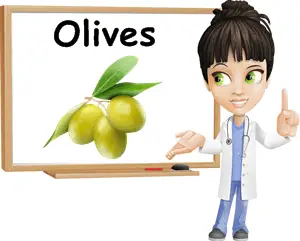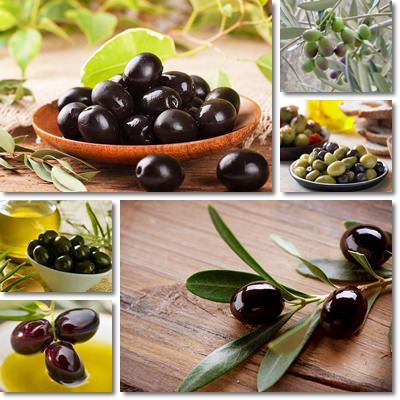One of the most widely consumed and expensive foods in the world, olives boast great antioxidant and anti-inflammatory properties. Although they are considered culinary vegetables, botanically, olives are a fruit. They are the fruit of the olive tree (Olea europaea), native to the Mediterranean Basin. One of the key-features of the fruit is their oily flesh, rich in healthy monounsaturated fatty acids which exert a powerful antioxidant and anti-inflammatory action on the cardiovascular system.
Olives, just like their main byproduct, olive oil, support cardiovascular health and protect against oxidative stress and chronic disease by preserving blood vessel integrity, lowering LDL (bad) cholesterol levels and preventing the oxidation of blood lipids. Moreover, as a result of their healthy unsaturated fatty acids content, olives support brain and nervous system activity and contribute to lowering inflammation levels in the body.

Facts about olive trees and olives
Olive trees are of medium height and bulky, with a somewhat twisted, at parts hollow trunk. Interesting fact: did you know that olive trees can easily live up to quite a few hundred years old and produce fruit throughout their lifespan? Olives, the fruit of the olive tree, are drupes, meaning they have a fleshy part surrounding a hard stone or pit. Olives ripen similar to mirabelles or plums, turning from green to red-purple and finally brown, violet or black. The green olives present in supermarkets or local farmers markets and brined (cured) green olives are, in fact, unripe. Another interesting fact: did you known that the brined (cured) black olives you buy are often dyed with the mineral iron? It’s an ‘edible’ or non-toxic form of iron, one that can be found in iron supplements.
What do olives look like?
Olive fruit are small and egg-shaped, that is, more elongated than round. They have a thin, smooth skin, firm to soft, meaty flesh with a hard, inedible, brown pit or stone in the center. Unripe olives are typically green, changing color as they ripen. Green olives with patches or smudges of red, purple, brown or violet are in the process of ripening, while dark brown, purple, violet and black olives indicate the fruit is mature.
What do olives taste like?
Freshly picked olives taste extremely bitter which is why they undergo special treatment before reaching supermarket shelves and our plates, to make them more palatable. Usually, treatments applied to the fruit involve the use of lye or salt or both. Olives in brine, also known as cured olives, are actually one of the most popular preparations of the fruit and make a wonderfully healthy prebiotic food for good gut health.
Depending on how they are prepared, brined or otherwise processed, olives will taste more or less oily, salty, bitter, sour or vinegary.
Different olive varieties will have different flavor profiles. Olives can taste rich and oily, with a delicate butter-like flavor and pleasant green, grassy notes. The taste can be more mild or stronger, sweeter or overtly bitter, or astringent.
Other flavors that can be identified in olives include fruitiness reminiscent of tropical fruit or peaches and nuttiness. Brined or cured olives, especially green ones, have a pregnant green, vinegary taste with a mildly bitter aftertaste.

What are the benefits of Olives?
According to more recent research, the health benefits of olive consumption derive mainly from the antioxidant and anti-inflammatory action of compounds in the fruit. One particularly important compound in the fruit is hydroxytyrosol, a powerful antioxidant phenol found in the pulp of fresh olives, olive oil and olive leaves.
Hydroxytyrosol has been shown to protect cells against oxidative stress caused by free radicals. By limiting cell damage and promoting cell repair, antioxidants are believed to significantly reduce the risks of chronic disease such as heart disease and cancer. The hydroxytyrosol in olives appears to be highly protective of lung health in smokers. Fresh olives are by far the best source of hydroxytyrosol because the antioxidant content is easily damaged by canning methods and other processes.
Traditional medical practices used olive pulp and leaves to treat inflammatory problems. According to researchers, at cell level, extracts from the fruit act similar to antihistamines by blocking special receptors triggering inflammation hence the anti-inflammatory action.
The olive fruit as well as olive oil are representative of the Mediterranean diet, an eating regimen known to lower both heart disease and osteoporosis risks.
Researchers focused on revealing the health benefits of the Mediterranean diet have found that eating olives is beneficial because it increases calcium absorption in bones, thus reducing osteoporosis risks.
Olive oil as well as fresh olives are a rich source of healthy monounsaturated fatty acids. It is estimated that olive oil is 3/4 or 75% monounsaturated fat, the most important of which being Omega-3. Fatty acids ensure the health of cell membranes through which cells communicate with each other. The healthy fats in olive oil, particularly Omega-3 fatty acids, further contribute to cognitive health. Fats are food for the brain as well physically part of the brain and nervous system cells, supporting cognitive functions and the activity of the nervous system.
See the benefits of olive oil.
Moreover, eating monounsaturated rich foods such as olives appears to lower high blood pressure and is thus beneficial for overall cardiovascular health, provided the healthy fats in the fruit replace other unhealthy fat sources in one’s diet and the total fat intake is considerably low. A serving of tuna, salmon or mackerel and 2-3 tablespoons of olive oil each day can do wonders for our health. If you do not like fish, you can chew on some walnuts, almonds or sunflower seeds or eat a handful of olives.
See: Is An Olive A Fruit Or A Vegetable?
Type of Omega-3 fatty acids in olive oil
Just remember that plant-based foods such as olives, olive oil, purslane etc. contain a type of Omega-3 called ALA, alpha linolenic acid. Animal foods such as fish and seafood and the oils obtained from marine foods (example: cod liver oil, krill oil), eggs and other sources of meat contain EPA and DHA Omega-3 fatty acids which are considered healthier forms. The human body only partially converts ALA Omega-3 forms into EPA and DHA so including both plant-based and animal foods into your diet can help achieve a balance and supply wonderful benefits for the brain, nervous system, skin and more. Find out more about the benefits of Omega-3 fatty acids and discover what is the difference between all the types of olive oil.
Last but not least, olives are an incredible source of antioxidants as well as anti-inflammatory compounds with great benefits on the cardiovascular, musculoskeletal, nervous, digestive and respiratory systems. Inflammation is the root of all disease, according to new scientific findings. Oxidative stress coming from free radicals damages cells and produces an inflammatory response in the body.
Moreover, inflammation has been linked to all sorts of chronic diseases such as diabetes, cancer, heart disease, even neurological diseases. Eating antioxidant-rich fruits, vegetables, nuts and seeds can improve overall health, keep inflammation levels low and offer protection against disease.
Depending on the variety and quality of the fruit, olives contains different amounts of antioxidant phenols, notably tyrosols, anthocyanins, quercitin and caffeic acid. In addition to this, they are a good source of vitamin E, a fat-soluble antioxidant vitamin that protects the skin against UV rays and sun damage. It is always best to choose quality brands with the least processed fruits. This will ensure both a enjoyable culinary experience and a generous intake of antioxidants, vitamins, minerals and healthy unsaturated fatty acids.
